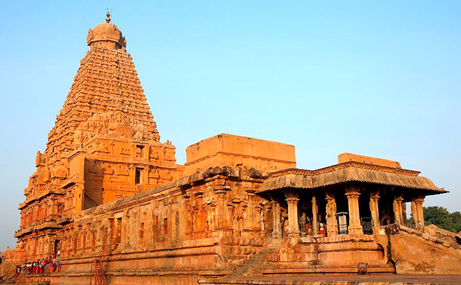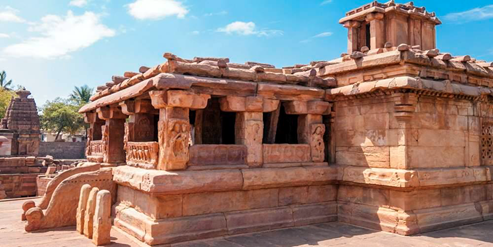Three key forms of temple architecture
By :
Three key forms of temple architecture
March 01, 2022
India is a land of rich and diverse art and culture. It is home to a number of architectural marvels, majority of which hold religious significance. Temples of India hold a very distinct place in the hearts of people. In layman’s terms, a temple can be defined as a place of worship. However, on a philosophical level, a Hindu temple represents much more. It is a manifestation of the entire cosmos that represents: earthly world (prithvi), the heavenly world (akasa), the astral world (svarga) and the world below (patala). Therefore, we find beautiful intricate carvings and paintings on the walls depicting not only major deities but also semi-divine deities, mythological creatures, flora, fauna and aquatic life.
The temple architecture has evolved over the ages and the style changes along with the changing dynasties and region. While the architecture of Hindu temples varies from region to region, the major components of a temple remain constant:
- Garbhagriha or the sanctum where the main idol of the deity is housed
- Mandapa or the portico which leads to the garbhagriha, where the worshipers assemble
- Shikhara that is the spire above the sanctum
- Vaahan which is the mount or vehicle of the main deity of the temple
Based on geographical location and architectural style, Hindu temples can be characterized under two broad categories—Nāgara, Drāvida. A third style of temple architecture – Vesara is also found. This is a hybrid style with adaptations from both Nāgara and Drāvida style. The distinction can be made by comparing the elevation of the temple, forms of the spire and the plan of the temple.
Nāgara

Kandariya Mahadev Temple at Khajuraho, Madhya Pradesh is an example of Nāgara Style of temple architecture
The plan of a Nāgara style of temple is four-sided. The garbhagriha is a perfect square whereas the whole temple plan could be oblong. The garbhagriha or sanctum sanctorum houses the image or idol of the main deity. The pathway leading to the garbhagriha is the mandapa where the worshipers accumulate to have darśana. In the early stage of temple construction, the roofs were flat (temple Number-17 at Sanchi, Madhya Pradesh). In the next stage of temple construction, the roof became pyramidal. This was the shikhara, a tall spire that tapered at the top. In the later stages, more additions were made to the temple complex. More mandapas were added and the garbhagriha was surrounded by a pradakshinapatha or a circumambulatory path. In some cases, gavaksa (windows) were added to allow cross ventilation for air and light.
A Nāgara temple generally rests on a high platform- jagati over which is constructed a small platform called pitha. Rising above this is a smaller platform- adhisthana, which forms the base for the construction of superstructure of the temple. Among the other components of a Nāgara temple are – bhadra, sirsa, amalaka, bijapuraka, rathika.
When it comes to decorating the temples, the Nāgara temples are intricately ornamented by carvings and sculptures. The entrance to the temple is highly decorated with images of gods and goddesses, floral and geometric designs. The bottom of the door frame depicts either dvarapalas or Ganga and Yamuna. On the walls and pillars of the temple, the sculptures and carvings depict devakanyas, apsaras, yaksas, yaksis, amalakas and floral garlands.
Drāvida

Brihadeshwar Temple at Thanjavur, Tamil Nadu, is an example of Drāvidian Style of temple architecture
The plan of a Drāvida temple, from the plinth to the finial, is hexagonal or octagonal. It is marked by terraces and are often multistoreyed. Drāvida temples are also frequently called Vimana (meaning ship or boat) and are marked by six major angas, namely:
- Adhisthana: the base of the structure on which the superstructure of the temple stands
- Pada: the walls which enclose the garbhagriha, with stambhas (pillars) in between
- Prastara: the beam or the architrave that denotes the end of the garbhagriha walls and the beginning of the spire
- Griva: the clerestory or rows of windows on the bottom of the spire and above the garbhagriha
- Shikhara: the spire rising above the griva
- Stupi: the finial in the shape of a stupa or kalasa that crowns the shikhara
The temples of the South are adorned with beautiful and elaborate decorative elements. The carvings of the sculpture are the first thing that catches your eyes. The decoration on the prastara goes around the entire structure just like a hara (garland) would and contains miniature vimana like shrines. The sculptures depended upon the deity to which the temple was dedicated to. For example, if it was a temple dedicated to Siva, one might find figures of bull and bhutas, and if the temple was dedicated to Visnu, it could depict Garuda or eagle. There are variations in styles of vimanas (kuta vimana, sala vimana, panjara vimana) of the temple as well.
Vesara

Lad Khan Temple at Aihole, Karnataka, is an example of Vesara Style of temple architecture
While the Nāgara and Drāvida types of temples have distinctive features of their own, Vesara type adopted from both in variety of ways. Consequently, one might notice a temple with square body at various talas but shikhara and griva to be circular, octagonal or apsidal. Similarly, the body might be oblong but the shikhara and griva could be elliptical. The distinction in this style is in the plan on which the temple’s superstructure is created. It is circular, ellipsoidal or apsidal from the foundation to the pinnacle.
More styles of architecture
Apart from these major types of temples found in Northern, Southern and Central parts of India, there are numerous more styles of temples with their unique distinctive features. For instance, temples of Odisha have similar components as found in the above-mentioned types but with certain regional individualities. The lower part of the temple is garbhagriha upon which is the elevated roof or shikhara that is called rekha vernacularly. The mandapa in front of the garbhagriha is termed jagamohana.
The temples of the hills have a unique tradition of their own. The buildings are built out of wood; also the roof is neither flat nor pyramidal but pitched. The temples, therefore, took the shape of pagodas at times.
The forms maybe many but all these magnificent temples narrate a story of rich and diverse cultural heritage of India.